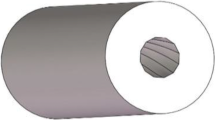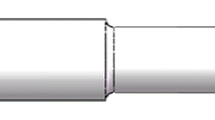Abstract
In the traditional precision and ultra-precision machining technology field, workpieces with irregular internal curved surfaces tend to have no subsequent processing after basic machining due to the limited processing means, and the surface quality of such workpieces is often not up to standard. Precision machining of abrasive flow can effectively improve this drawback and improve the surface quality of the irregular inner curved surface. In order to propose the quality control technology of the precision machining of the irregular inner curved surface of the abrasive flow, this paper uses large eddy simulation method as research means, analyzes the precision machining mechanism of abrasive flow machining curved flow channel workpiece by four different sub-grid models, establishes a reasonable sub-grid-scale model, and analyzes the abrasive flow precision machining mechanism of spiral flow channel with this model. It is found that shear force increases with the increase of inlet pressure, the interaction effect of particles in the abrasive flow and the wall surface of the flow channel is enhanced, the turbulence and disorder effect of the fluid is improved, burrs and scratches on the surface are effectively removed, and the surface quality of the workpiece is improved. The greater the inlet pressure, the stronger the turbulence effect and the higher the processing efficiency of the abrasive flow, and the better the precision machining quality of abrasive flow. Properly increasing the inlet pressure can obtain a higher surface quality of the irregular inner curved surface workpiece.














Similar content being viewed by others
References
Petare AC, Jain NK (2018) A critical review of past research and advances in abrasive flow finishing process. Int J Adv Manuf Technol 97(1-4):741–782. https://doi.org/10.1007/s00170-018-1928-7
Sato T, Soh E, Nakayama Y, Shinagawa M, Fukuchi Y (2016) Effect of media degradation on finishing characteristics in abrasive flow machining. Mater Sci Forum 4389:127–132. https://doi.org/10.4028/www.scientific.net/MSF.874.127
Sankar MR, Jain VK, Ramkumar J (2016) Nano-finishing of cylindrical hard steel tubes using rotational abrasive flow finishing (R-AFF) process. Int J Adv Manuf Technol 85(9-12):2179–2187. https://doi.org/10.1007/s00170-015-8189-5
Fu YZ, Wang XP, Gao H, Gao H, Wei HB, Li SC (2016) Blade surface uniformity of blisk finished by abrasive flow machining. Int J Adv Manuf Technol 84(5-8):1725–1735. https://doi.org/10.1007/s00170-015-8270-0
Duval-Chaneac MS, Han S, Claudin C, Salvatore F, Bajolet J, Rech J (2018) Experimental study on finishing of internal laser melting (SLM) surface with abrasive flow machining (AFM). Precis Eng 54:1–6. https://doi.org/10.1016/j.precisioneng.2018.03.006
Singh S, Kumar D, Ravi Sankar MR, Jain VK (2019) Viscoelastic medium modeling and surface roughness simulation of microholes finished by abrasive flow finishing process. Int J Adv Manuf Technol 100(5-8):1165–1182. https://doi.org/10.1007/s00170-018-1912-2
Li JY, Su NN, Wei LL, Zhang XM, Yin YL, Zhao WH (2019) Study on the surface forming mechanism of the solid–liquid two-phase grinding fluid polishing pipe based on large eddy simulation. P I Mech Eng B-J Eng 14:2505–2514. https://doi.org/10.1177/0954405419841814
Silvis MH, Remmerswaal RA, Verstappen R (2017) Physical consistency of subgrid-scale models for large-eddy simulation of incompressible turbulent flows. Phys Fluids 29(1):015105. https://doi.org/10.1063/1.4974093
Zhang Y, Kihara H, Abe KI (2017) On the effect of an anisotropy-resolving subgrid-scale model on large eddy simulation predictions of turbulent open channel flow with wall roughness. J Turbul 18(9):809–824. https://doi.org/10.1080/14685248.2017.1333617
Linkmann M, Buzzicotti M, Biferale L (2018) Multi-scale properties of large eddy simulations: correlations between resolved-scale velocity-field increments and subgrid-scale quantities. J Turbul 19(6):493–527. https://doi.org/10.1080/14685248.2018.1462497
Mao J, Zhang K, Liu K (2017) Comparative study of different subgrid-scale models for large eddy simulations of magnetohydrodynamic turbulent duct flow in OpenFOAM. Comput Fluids 152:195–203. https://doi.org/10.1016/j.compfluid.2017.04.024
Wang AC, Cheng KC, Chen KY, Chen KY, Lin YC (2018) A study on the abrasive gels and the application of abrasive flow machining in complex-hole polishing. Procedia Cirp 68:523–528. https://doi.org/10.1016/j.procir.2017.12.107
Li J, Ji SM, Tan DP (2017) Improved soft abrasive flow finishing method based on turbulent kinetic energy enhancing. Chinese J Mech Eng 30(2):301–309. https://doi.org/10.1007/s10033-017-0071-y
Qi H, Wen DH, Yuan QL, Zhang L, Chen ZZ (2016) Numerical investigation on particle impact erosion in ultrasonic-assisted abrasive slurry jet micro-machining of glasses. Powder Technol 314:627–634. https://doi.org/10.1016/j.powtec.2016.08.057
Awad E, Toorman E, Lacor C (2009) Large eddy simulations for quasi-2D turbulence in shallow flows: a comparison between different subgrid scale models. J Mar Syst 77(4):511–528. https://doi.org/10.1016/j.jmarsys.2008.11.011
Ge JQ, Ji SM, Tan DP (2018) A gas-liquid-solid three-phase abrasive flow processing method based on bubble collapsing. Int J Adv Manuf Technol 95(1):1069–1085. https://doi.org/10.1007/s00170-017-1250-9
Smagorinsky J (1963) General circulation experiments with the primitive equations. Mon Weather Rev 91(3):99–164. https://doi.org/10.1175/1520-0493(1963)091<0099:GCEWTP>2.3.CO;2
Nicoud F, Ducros F (1999) Subgrid-scale stress modelling based on the square of the velocity gradient tensor. Flow Turbul Combust 62(3):183–200. https://doi.org/10.1023/A:1009995426001
Shur ML, Spalart PR, Strelets MK, Travin AK (2008) A hybrid RANS-LES approach with delayed-DES and wall-modelled LES capabilities. Int J Heat Fluid Fl 29(6):1638–1649. https://doi.org/10.1016/j.ijheatfluidflow.2008.07.001
Kim WW, Menon S (2013) Application of the localized dynamic subgrid-scale model to turbulent wall-bounded flows. 35th Aerospace Sciences Meeting and Exhibit. https://doi.org/10.2514/6.1997-210
Miao C, Shafrir SN, Lambropoulos JC, Mich J, Jacobs SD (2009) Shear stress in magnetorheological finishing for glasses. Appl Opt 48:2585–2594. https://doi.org/10.1364/AO.48.002585
Jain RK, Jain VK, Dixit PM (1999) Modeling of material removal and surface roughness in abrasive flow machining process. Int J Mach Tools Manuf 39:1903–1923. https://doi.org/10.1016/S0890-6955(99)00038-3
Li WH, Li XH, Yang SQ, Li WD (2018) A newly developed media for magnetic abrasive finishing process: material removal behavior and finishing performance. J Mater Process Technol 260:20–29. https://doi.org/10.1016/j.jmatprotec.2018.05.007
Kathiresan S, Mohan B (2020) Multi-objective optimization of magneto rheological abrasive flow nano finishing process on AISI stainless steel 316L. J Nano R 63:98–111. https://doi.org/10.4028/www.scientific.net/JNanoR.63.98
Acknowledgements
The authors would like to thank the National Natural Science Foundation of China No. NSFC 51206011 and U1937201, Jilin Province Science and Technology Development Program of Jilin Province No. 20200301040RQ, Project of Education Department of Jilin Province No. JJKH20190541KJ, and Changchun Science and Technology Program of Changchun City No. 18DY017.
Author information
Authors and Affiliations
Contributions
Weihong Zhao designed and performed the manuscript, analyzed the data, and drafted the manuscript. Jiyong Qu and Junye Li analyzed the data and supervised this study. Ningning Su and Guangfeng Shi conceived the project, and Jianhe Liu organized the paper and edited the manuscript. All authors read and approved the manuscript.
Corresponding author
Ethics declarations
Ethics approval
Not applicable.
Consent to participate
Not applicable.
Consent for publication
All presentations of case reports have consent for publication.
Conflict of interest
The authors declare no competing interests.
Additional information
Publisher’s note
Springer Nature remains neutral with regard to jurisdictional claims in published maps and institutional affiliations.
Rights and permissions
About this article
Cite this article
Zhao, W., Qu, J., Li, J. et al. Research on quality analysis of solid-liquid two-phase abrasive flow precision machining based on different sub-grid scale models. Int J Adv Manuf Technol 119, 1693–1706 (2022). https://doi.org/10.1007/s00170-021-07604-3
Received:
Accepted:
Published:
Issue Date:
DOI: https://doi.org/10.1007/s00170-021-07604-3




